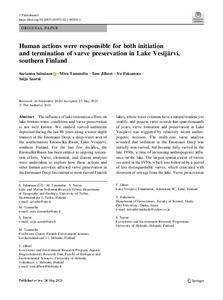Human actions were responsible for both initiation and termination of varve preservation in Lake Vesijärvi, southern Finland
Jilbert Tom; Fukumoto Yu; Salminen Sarianna; Saarni Saija; Tammelin Mira
https://urn.fi/URN:NBN:fi-fe2021100750276
Tiivistelmä
The influence of lake restoration efforts on lake bottom-water conditions and varve preservation is not well known. We studied varved sediments deposited during the last 80 years along a water-depth transect in the Enonsaari Deep, a deep-water area of the southernmost Enonselkä Basin, Lake Vesijärvi, southern Finland. For the last few decades, the Enonselkä Basin has been subject to ongoing restoration efforts. Varve, elemental, and diatom analyses were undertaken to explore how these actions and other human activities affected varve preservation in the Enonsaari Deep. In contrast to most varved Finnish lakes, whose water columns have a natural tendency to stratify, and possess varve records that span thousands of years, varve formation and preservation in Lake Vesijärvi was triggered by relatively recent anthropogenic stressors. The multi-core varve analysis revealed that sediment in the Enonsaari Deep was initially non-varved, but became fully varved in the late 1930s, a time of increasing anthropogenic influence on the lake. The largest spatial extent of varves occurred in the 1970s, which was followed by a period of less distinguishable varves, which coincided with diversion of sewage from the lake. Varve preservation weakened during subsequent decades and was terminated completely by lake aeration in the 2010s. Despite improvements in water quality, hypolimnetic oxygen depletion and varve preservation persisted beyond the reduction in sewage loading, initial aeration, and biomanipulation. These restoration efforts, however, along with other human actions such as harbor construction and dredging, did influence varve characteristics. Varves were also influenced by diatom responses to anthropogenic forcing, because diatoms form a substantial part of the varve structure. Of all the restoration efforts, a second episode of aeration seems to have had the single most dramatic impact on profundal conditions in the basin, resulting in replacement of a sediment accumulation zone by a transport or erosional zone in the Enonsaari Deep. We conclude that human activities in a lake and its catchment can alter lake hypolimnetic conditions, leading to shifts in lake bottom dynamics and changes in varve preservation.
Kokoelmat
- Rinnakkaistallenteet [19207]
